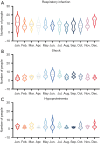Epidemiological characteristics of pediatric patients with burn complications and influence between 2016 and 2021: a multi-center retrospective study
- PMID: 40519725
- PMCID: PMC12163808
- DOI: 10.21037/tp-2025-20
Epidemiological characteristics of pediatric patients with burn complications and influence between 2016 and 2021: a multi-center retrospective study
Abstract
Background: Currently, domestic and international studies on post-burn complications are limited to single diseases, and a single center or on a small scale. Therefore, this large-scale study aimed to describe the epidemiological characteristics of pediatric burns and their complications in China to notify the occurrence of burn complications.
Methods: This study included 11,092 pediatric burn medical records of Futang Research Center of Pediatric Development (FRCPD) database between January 1, 2016, and December 31, 2021. General and hospitalization information for patients with the first diagnosis of "T20-T32" [according to the 10th revision of the International Classification of Diseases, burns and corrosions of external body surface, specified by site (T20-T25), burns and corrosions confined to eye and internal organs (T26-T28), burns and corrosions of multiple and unspecified body regions (T29-T32)] was extracted.
Results: This retrospective, large-scale, and multi-center study included pediatric burn cases in the FRCPD database. The prevalence of respiratory infections was 5.5%, shock was 2.8%, hypoproteinemia was 1.3%. In terms of age, children <1 year' incidence of respiratory infections and anemia was 6.9% and 3.2% (P<0.001). The rates of myocardial damage and esophageal stenosis in children aged 15-18 years were 18.8%. For burn causes, respiratory infection caused by hydrothermal scald was 3.7%, flame was 14.7% and chemical was 26.6%. Myocardial damage caused by electric was 8.5%. For burns in the trunk, the proportion causing shock and hypoproteinemia were 24.4% and 10.5%, respectively.
Conclusions: Boys, 1-3 years, and children whose hospitals in urban areas were susceptible to burns from hydrothermal scalds. Children aged 4-7 years were susceptible to shock due to flame burns involving limbs or multiple parts. In terms of age, children <1 year had the highest incidence of respiratory infections and anemia among all age groups. The rates of myocardial damage and esophageal stenosis in children aged 15-18 years were highest in different age groups. From burn causes, myocardial damage was the most common complications caused by electric. From burn area, the most common areas for shock and hypoproteinemia were the trunk.
Keywords: Epidemiological characteristics; complications; large-scale; multi-center; pediatric burn patients.
Copyright © 2025 AME Publishing Company. All rights reserved.
Conflict of interest statement
Conflicts of Interest: All authors have completed the ICMJE uniform disclosure form (available at https://tp.amegroups.com/article/view/10.21037/tp-2025-20/coif). The authors have no conflicts of interest to declare.
Figures



Similar articles
-
Epidemiology and outcome analysis of scalds in children caused by "guo lian kang": an 11-year review in a burn center in China.Burns. 2015 Mar;41(2):289-96. doi: 10.1016/j.burns.2014.07.013. Epub 2014 Oct 28. Burns. 2015. PMID: 25440853
-
[Epidemiological investigation on 1 946 hospitalized pediatric patients with burns].Zhonghua Shao Shang Za Zhi. 2018 Oct 20;34(10):696-700. doi: 10.3760/cma.j.issn.1009-2587.2018.10.009. Zhonghua Shao Shang Za Zhi. 2018. PMID: 30369137 Chinese.
-
[Analysis of clinical data of 16 595 pediatric burn patients during fifteen years].Zhonghua Shao Shang Za Zhi. 2013 Feb;29(1):6-10. Zhonghua Shao Shang Za Zhi. 2013. PMID: 23710716 Chinese.
-
Epidemiology of pediatric burns requiring hospitalization in China: a literature review of retrospective studies.Pediatrics. 2008 Jul;122(1):132-42. doi: 10.1542/peds.2007-1567. Pediatrics. 2008. PMID: 18595996 Review.
-
[Systematic review of the epidemiological characteristics of inhalation injury in burn patients in China].Zhonghua Shao Shang Za Zhi. 2021 Jul 20;37(7):654-660. doi: 10.3760/cma.j.cn501120-20200306-00129. Zhonghua Shao Shang Za Zhi. 2021. PMID: 34192849 Free PMC article. Chinese.
References
-
- Burns [Internet]. [cited 2025 Apr 20]. Available online: https://www.who.int/news-room/fact-sheets/detail/burns
LinkOut - more resources
Full Text Sources
